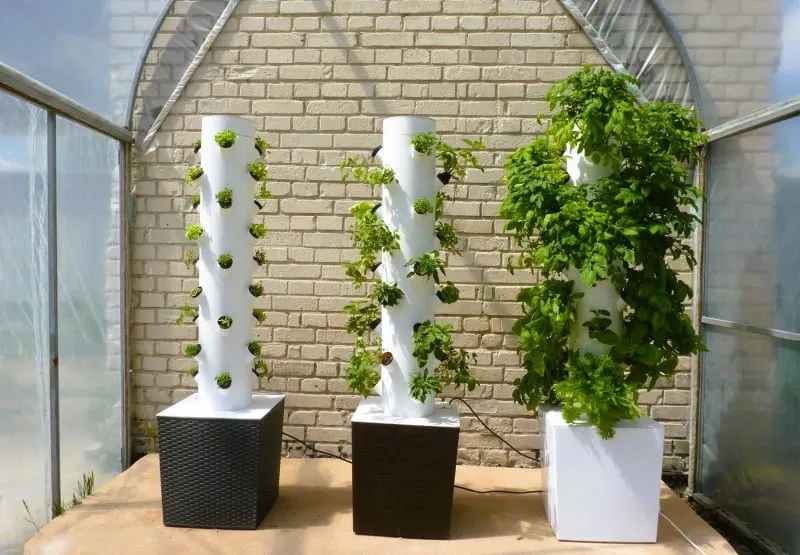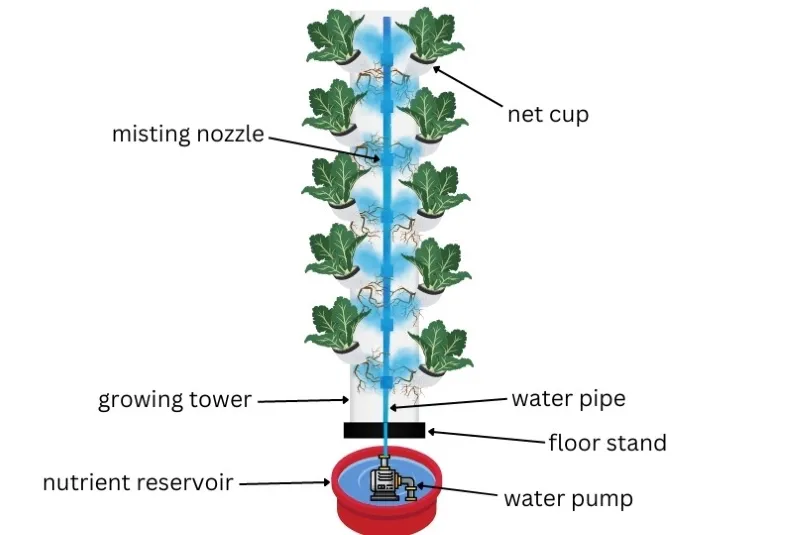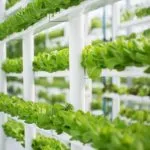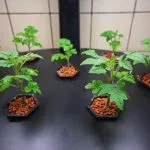In the realm of modern gardening, an aeroponic tower stands as an innovative method that optimizes plant growth while conserving environmental resources. This blog post aims to delve into the fascinating concept of aeroponic towers, explaining what they are and how they work. We will explore the unique design, functioning, and benefits of these innovative gardening systems.

Aeroponics represents a soilless growing procedure where plants are grown in an air or mist environment. It has been recognized as an effective technique for its utilization of nutrients and water, saving up to 98% water compared to conventional farming methods. The system also allows for faster growth rates and higher yields due to enhanced access to oxygen.
But what is an aeroponic tower and how does it fit into the wider concept of aeroponics? Well, tower garden aeroponics is the centerpiece of this approach – a vertical structure designed to maximize space efficiency and exposure to light. In these towers, plants grow outward from their holes, with roots hanging inside the tower exposed to nutrient-rich mist.
- What Is An Aeroponic Tower? Understanding Aeroponic Towers
- How Do Aeroponic Towers Work?
- Vertical Aeroponic Tower Garden Diagram
- Aeroponic Tower Vs Hydroponic Tower
- Advantages of Aeroponic Towers
- Challenges and Limitations of Aeroponic Towers
- Types of Plants Grown on Aeroponic Towers
- Successful Applications of Aeroponic Towers
- Tips for Successful Aeroponic Gardening
- Frequently Asked Questions
What Is An Aeroponic Tower? Understanding Aeroponic Towers
Aeroponic towers are a marvel of modern gardening, showcasing the innovative application of technology in horticulture. These vertical gardening systems take plant cultivation to new heights, literally and metaphorically. An aeroponic tower is a form of a hydroponic tower garden.
The structure of aeroponic towers is composed primarily of two elements – the tower frame and the support structure. The tower frame forms the spine of this vertical garden, providing an upright framework for plant growth. It is traditionally tall and slender, allowing plants to grow upwards instead of outwards. The support structure stabilizes the tower frame, ensuring it remains upright and firm even as plants burgeon on its surface.
Within this towering edifice lies several growing chambers or pods. These pods are specially designed spaces within the tower where individual plants are housed. The leaves and stems grow outside of the tower while the roots grow inside. The pods offer the perfect environment for roots to expand and flourish, while still contributing to the compact vertical layout.
Integral to aeroponic towers is their nutrient delivery system which consists mainly of pumps and misters or spray nozzles. This system operates much like a circulatory system in a living organism: it delivers vital nutrients directly to plant roots via an ultra-fine mist – hence, “aero” in aeroponics (pertaining to air). The pumps aid in moving nutrient-rich water from its source to every plant’s root zone within the tower.
Lastly, at the base of these towers reside water reservoirs that serve as storage units for both fresh water and nutrient solutions. As part of this reservoir system, filtration mechanisms are used to purify water before it’s sent up through the pumps into misters or spray nozzles. After spraying onto roots, excess moisture trickles down back into this reservoir for recirculation.
In summary, aeroponic towers stand as magnificent structures harnessing advanced technologies for efficient plant growth. With carefully engineered components like growing chambers and nutrient delivery systems involving pumps and spray nozzles working seamlessly together with a dedicated water reservoir and filtration setup, they pave way for robust plant development – all stacked vertically within these towers. If you think that this system sounds complicated, it doesn’t have to be if you follow our comprehensive guide on how to make an aeroponic tower garden yourself.
Related: If you’d like to buy a tower system, we have carefully curated the best aeroponic tower gardens available right now.
How Do Aeroponic Towers Work?
So, how exactly do these innovative towers work? Let’s delve into a detailed step-by-step process:
- Planting Seeds or Seedlings in the Growing Chambers/Pods: The journey begins with planting seeds or seedlings in specially designed chambers or pods on the tower. Each pod acts as a standalone micro-ecosystem for each plant, providing it with the necessary conditions to grow.
- Nutrient-Rich Water Supply and Circulation System Explained: Instead of relying on soil, aeroponic towers utilize a nutrient solution to provide all the necessary nutrients to the plants. This solution is often water-based and rich in vital minerals required for plant growth. The system circulates this nutrient-infused water around all parts of the tower, ensuring every plant gets an equal share.
- The Role of Misters in Delivering Nutrients and Oxygen to Plant Roots: For optimal nutrient absorption and oxygen supply, aeroponic towers use misters. These devices spray a fine mist of nutrient solution directly onto the roots of crops within the tower. They follow a proper misting schedule so that the roots don’t get over- or under-watered. This direct exposure allows plant roots to absorb nutrients more efficiently while also supplying them with ample oxygen—a critical element for healthy root development.
- Monitoring Environmental Factors for Optimal Growth: Just like any other form of agriculture, environmental factors such as temperature and humidity play a crucial role in determining crop health and yield in aeroponic towers. Therefore, continuous monitoring of these factors is essential for maintaining optimal growing conditions inside the tower.
Vertical Aeroponic Tower Garden Diagram

Aeroponic Tower Vs Hydroponic Tower
An Aeroponic Tower
- An aeroponic tower employs an aeroponics system, where plants are grown in an air or mist environment without the use of soil or other aggregate medium. This tower’s design often has a central column that houses the misting system, and the plants protrude outward from this column.
- Instead of drenching the roots in nutrient-filled water, like hydroponics, an aeroponic tower sprays a fine mist of nutrients onto them. This allows for increased oxygen intake by the roots and faster growth rates.
- Since it uses less water and nutrients than hydroponics, it is highly efficient and sustainable. However, because of its complex setup involving high-pressure pumps and spray nozzles, maintaining an aeroponic tower can be challenging.
- The risk associated with aeroponic towers is higher since any failure such as a pump malfunction or power outage could cause the plant roots to dry out quickly.
A Hydroponic Tower
- A hydroponic tower operates on a hydroponics system in which plants are grown in a mineral nutrient solution instead of soil. These towers typically consist of multiple levels or layers where plants are placed within their own pods or spaces.
- The roots are submerged continuously or periodically in nutrient-rich water. While this uses more water than aeroponics, it still reaps benefits such as saving more water compared to traditional agriculture methods.
- Compared to aeroponics towers, hydroponic systems tend to be simpler and easier to maintain due to fewer mechanical parts involved.
- As these systems rely on a constant supply of water for nutrient uptake by the plant root system, they are also vulnerable to power outages or pump failures.
In conclusion, both systems offer innovative solutions for growing plants without soil while optimizing resources like space, water and nutrients. The choice between adopting an aeroponic tower versus a hydroponic tower largely depends on factors such as access to resources (water & nutrients), skill level required (system setup & maintenance), tolerance for risk (potential failures) and specific crop requirements. Even if you don’t choose vertical aeroponics, the differences between hydroponics and aeroponics are similar.
Related: Here’s our guide for choosing the best vertical hydroponic system.
Advantages of Aeroponic Towers
An aeroponic tower or vertical aeroponics system, an innovative technique in modern farming, offers numerous advantages that enhance sustainable and highly productive agriculture. Here are some key benefits:
- Improved Resource Efficiency Compared to Traditional Farming Methods: The tower aeroponics system inherently offers superior resource efficiency compared to conventional farming methods.
- Less Water Usage: The towers structure includes a reservoir and pump that deliver a nutrient-rich solution directly to the roots of the plants through spray nozzles. This targeted nutrient delivery system results in substantially less water usage than traditional irrigation.
- Reduced Land Requirement: Thanks to its vertical gardening design, an aeroponic tower can accommodate more plants in a smaller area, significantly reducing the land requirement.
- Elimination of Soil-Borne Diseases and Pests: Since soil is not involved in this method, harmful soil-borne diseases and pests are effectively eliminated.
- Year-Round Productivity and Potential for Urban Farming: Unlike traditional farming methods that rely on seasonal changes, these towers allow for year-round productivity regardless of exterior weather conditions. Not only does this increase total output, but it also presents potential for urban farming where arable land might be scarce.
- Increased Crop Yield and Faster Growth Rates: By providing optimal nutrient delivery and eliminating common growth impediments like pests or diseases, plants grown within an aeroponic tower experience faster growth rates compared to conventional methods. Consequently, the aeroponic method leads to increased crop yield over a shorter period of time.
Challenges and Limitations of Aeroponic Towers
Aeroponic tower gardening can be incredibly rewarding, providing fresh produce in a condensed space with less water and fewer pesticides compared to traditional methods. However, there are some challenges to consider before you dive headfirst into this innovative style of gardening.
- Maintenance Requirements and System Complexity: One significant challenge of aeroponic towers is the maintenance they require. Because these systems have various mechanical parts such as misters, pumps, and timers that allow the plants to grow without soil, they require regular checking, cleaning, and sometimes repairing or replacing. The complexity of the system also presents its own issues. As a new gardener or someone transitioning from traditional gardening methods, the learning curve might be steep. Understanding how to manage pH levels in the nutrient solution, when and how much to mist plant roots, or even selecting plants that will thrive in an aeroponic environment can take time and patience.
- Initial Investment Costs Compared to Traditional Gardening Methods: Starting a vertical aeroponic tower garden involves higher initial investment costs than setting up a traditional garden. The cost includes the tower itself along with necessary equipment like pumps, timers, growth lights (if indoors), testing kits for nutrients and pH balance control mechanisms. Besides equipment costs, ongoing expenses include water filters (if using tap water), electricity for pump operation and lighting (for indoor systems), as well as nutrient solutions specifically designed for aeroponics use. It’s important to note though that while upfront costs are higher for aeroponic systems compared with traditional gardens, over time this investment can pay off due to increased yield efficiency and decreased water usage.
- Risk of System Failure Due To Power Outages or Equipment Malfunctions: Lastly, one major challenge all prospective aeroponic gardeners must consider is that these systems rely heavily on functional hardware – power outages or equipment malfunctions can cause substantial damage in short periods. In case of a power outage or failure of critical components like pumps or misting nozzles— roots may dry out rapidly causing irreversible damage to your crops if not addressed quickly. Therefore it’s crucial not just to maintain but also monitor an aeroponic system regularly so any problems can be rectified promptly.
Types of Plants Grown on Aeroponic Towers
Aeroponic towers are known for their versatility. They can support a wide variety of plant types, enhancing your culinary experience and adding beauty to your environment.
- Vegetables: A vast array of vegetables thrive in these towers. From tomatoes, cucumbers, and bell peppers to zucchini and squash, you can enjoy a bountiful harvest from the convenience of your own home. The nutrient-rich mist helps these veggies grow quickly and robustly.
- Fruits: Various types of fruits can also be cultivated in aeroponic towers. Strawberries are particularly successful due to their compact growth habit, but other fruits like melons can also be grown if properly supported.
- Herbs: Herbs flourish in an aeroponic environment as well. Whether you’re looking to grow cilantro, basil, rosemary or thyme, these towers make it simple to have fresh herbs at your fingertips year-round.
- Leafy Greens: Lettuce varieties such as butterhead or romaine are perfect for tower growing because they need less light than fruiting plants. Other leafy greens like kale, spinach, and swiss chard also do exceptionally well in this type of system.
- Microgreens: These nutrient-packed mini versions of mature greens are ideal candidates for aeroponic cultivation. From broccoli microgreens to radish sprouts, growing these tender shoots couldn’t be easier with an aeroponic tower.
The diversity of plants you can grow on an aeroponic tower is impressive. As long as they aren’t too large or heavy for the tower structure (like full-sized fruit trees), you should be able to experiment with a broad range of vegetables, fruits, herbs, leafy greens and microgreens.
Successful Applications of Aeroponic Towers
Aeroponic towers have found great success in various areas, demonstrating their versatility and effectiveness. Following are some of the real-life applications where these innovative systems have made a significant difference.
Real-Life Examples of Successful Aeroponic Tower Gardens
From patios to backyards, aeroponic tower gardens have transformed green spaces into lush, productive food sources. These vertical gardening units can be seen sprouting an abundance of greens in urban homes as well as suburban neighborhoods. They not only beautify the surroundings but also provide fresh, organic produce right at your doorstep.
Commercial Applications in Urban Areas:
Urban agriculture has taken a leap forward with the introduction of aeroponic towers. They have emerged as successful commercial initiatives especially in areas where space is scarce. The concept of growing vertically allows businesses to maximize yield within a minimal footprint, making it ideal for urban environments. Businesses ranging from small cafes to large restaurants now grow their own herbs and vegetables using these towers.
Rooftop Gardens and Community Initiatives:
Cities across the globe are recognizing the value of green roofs in battling pollution and reducing energy consumption. By installing aeroponic towers on rooftops, residents and communities are turning underused spaces into thriving food gardens. These rooftop gardens serve dual purposes – sustainable food production and contributing towards a greener urban environment.
Community initiatives are increasingly utilizing aeroponic systems to promote local food production and community building. It’s not uncommon to find these towers sprouting up in the corner of a public park or gracing a shared patio area.
Educational Institutions Promoting Sustainable Agriculture:
Educational institutions are embracing aeroponic tower gardens as teaching tools for sustainable agriculture practices. Schools and universities incorporate these systems into their curriculums to give students hands-on experience in growing food sustainably. In addition, they also contribute to promoting healthy eating habits among students by providing access to fresh produce right on campus.
Tips for Successful Aeroponic Gardening
Aeroponic gardening can yield impressive results, both in terms of plant health and crop yield. However, it’s not as simple as just setting up your vertical aeroponics tower garden and waiting for the magic to happen. There are a few essential factors that you’ll need to monitor and manage carefully to achieve the best possible outcome. Here are some tips to help you succeed with your aeroponic gardening.
Choosing Suitable Plant Varieties
One of the first steps towards successful aeroponic gardening is selecting plants that will thrive in this specific type of environment. Not all plants are suitable for the aeroponic system; leafy greens, herbs, strawberries, tomatoes, peppers, cucumbers, and some types of flowers tend to fare well in an aeroponic setup. Choose plant varieties that have been proven to perform well under these conditions.
Proper Nutrient Composition and pH Levels
Next is ensuring that your nutrient solution composition and pH levels are optimized for your chosen plants’ needs. Plants grown using the aeroponic method depend entirely on the nutrient solution you provide them with, as there’s no soil involved in their growth process. It is crucial to maintain an appropriate balance of micro and macro nutrients suited for your plant variety. Moreover, maintaining a pH level between 5.5-6.5 typically promotes optimal nutrient uptake.
Regular Monitoring of Water Quality, Temperature, and Humidity
Water quality should be periodically tested since any imbalances can quickly lead to plant stress or disease. The temperature within your growing environment also heavily influences plant growth. Plants in an aeroponic tower garden need a specific temperature range for optimal growth, which can be hard to maintain. Most plants prefer temperatures between 65-75 degrees Fahrenheit (18-24 Celsius).
Similarly important is monitoring humidity levels; high humidity can promote fungal diseases while too low can lead to dehydration issues.
Common Issues Encountered in Aeroponic Tower Systems
Finally, being prepared to troubleshoot common issues will ensure long-term success with your aeroponic garden. Root rot is one such problem often encountered; it’s
Another frequent issue involves nutrient deficiencies which appear as discolored or stunted leaves among other symptoms- reinforcing how critical proper nutrient management truly is.
Sure, here are some common problems you might encounter with an aeroponic tower garden:
- Power Outages or Water Pump Failure: A loss of electricity would stop the water pump and other systems critical to your plants’ survival. The water pump is crucial for the functioning of the aeroponic system. If it fails, plants can quickly dry out and die.
- Clogging of Nozzles: The misting nozzles that deliver nutrients to the roots can get clogged with particles or bacterial growth, interrupting the nutrient flow.
- Root Diseases: Root rot is usually caused by poor aeration or pathogenic attack which highlights the importance of regular system cleaning and sterilization. Without proper sanitation, root diseases such as Pythium or Fusarium can spread rapidly in an aeroponic system.
- Poor Plant Support: In some cases, heavy fruiting crops may need additional support that is not provided by the tower structure.
- Lighting Issues: Indoor aeroponic systems require adequate artificial lighting—too little light will stunt growth while too much may burn plants. Outdoor towers need to be rotated regularly so that all the plants around the tower get an equal amount of direct and indirect sunlight through the day.
Armed with these tips in mind you’re set up well on your way towards successful aeroponic gardening!







